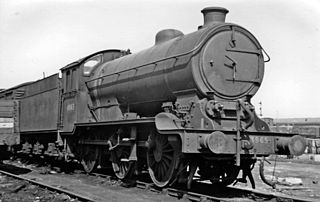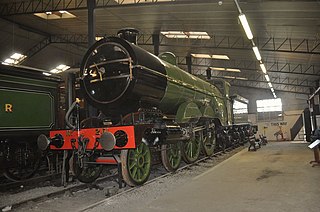
Sir Herbert Nigel Gresley was a British railway engineer. He was one of Britain's most famous steam locomotive engineers, who rose to become Chief Mechanical Engineer (CME) of the London and North Eastern Railway (LNER). He was the designer of some of the most famous steam locomotives in Britain, including the LNER Class A1 and LNER Class A4 4-6-2 Pacific engines. An A1 Pacific, Flying Scotsman, was the first steam locomotive officially recorded over 100 mph in passenger service, and an A4, number 4468 Mallard, still holds the record for being the fastest steam locomotive in the world (126 mph).

The London and North Eastern Railway (LNER) Class V2 2-6-2 steam locomotives were designed by Sir Nigel Gresley for express mixed traffic work, and built at the LNER shops at Doncaster and Darlington between 1936 and 1944. The best known is the first of the class, 4771 Green Arrow, which is the sole survivor of the class.

The London and North Eastern Railway (LNER) Thompson Class B1 is a class of steam locomotive designed by Edward Thompson for medium mixed traffic work.

The London and North Eastern Railway Gresley Classes A1 and A3 locomotives represented two distinct stages in the history of the British 4-6-2 "Pacific" steam locomotives designed by Nigel Gresley. They were designed for main line passenger services and later express passenger services, initially on the Great Northern Railway (GNR), a constituent company of the London and North Eastern Railway after the amalgamation of 1923, for which they became a standard design. The change in class designation to A3 reflected the fitting to the same chassis of a higher pressure boiler with a greater superheating surface and a small reduction in cylinder diameter, leading to an increase in locomotive weight. Eventually all of the A1 locomotives were rebuilt, most to A3 specifications, but no. 4470 was completely rebuilt as Class A1/1.

The London and North Eastern Railway (LNER) Class J39 was a class of medium powered 0-6-0 steam locomotive designed for mixed-traffic work throughout the former LNER system between London and the north of Scotland.

The Great Northern Railway 521 Class was a class of 0-6-0 steam locomotives, introduced in 1911. They were designed by Henry Ivatt for goods traffic. From 1912 to 1922 further examples, slightly modified by Nigel Gresley, were built and designated 536 Class. The most obvious difference was in the front sandboxes. These were below the running plate on the 521 but above it and merged with the front splashers, on the 536. The boiler and firebox were also moved back, thus resulting in a shortened cab. The London and North Eastern Railway classified them both as J6.

The North Eastern Railway Class S3, classified B16 by the LNER, was a class of 4-6-0 steam locomotive designed for mixed traffic work. It was designed by Vincent Raven and introduced in 1920. The earlier members of this class were fitted with Westinghouse Brakes - all of this equipment was removed during the 1930s.
Edward Thompson was an English railway engineer, and was Chief Mechanical Engineer of the London and North Eastern Railway between 1941 and 1946. Edward Thompson was born at Marlborough, Wiltshire on 25 June 1881. He was the son of Francis Thompson, assistant master at Marlborough College. He was educated at Marlborough before taking the Mechanical Science Tripos at Pembroke College, Cambridge, earning a third class degree. Thompson entered the railway scene after education, contrasting that of his predecessor Nigel Gresley, who had also attended Marlborough after gaining practical experience as a pupil at Horwich Works.

The Great Northern Railway Class J23 was a class of 0-6-0T steam locomotive. They had long side tanks that came to the front of the smokebox, which sloped forwards to improve visibility and had a recess cut in to aid maintenance. Forty were built by the Great Northern Railway (GNR) between 1913 and 1922, with a further 62 being added by the London and North Eastern Railway (LNER) between 1924 and 1939. They were given the nickname "Submarines" due to their long tanks.

The London and North Eastern Railway (LNER) Class K4 is a class of 2-6-0 steam locomotives designed by Nigel Gresley for the steep grades of the West Highland Line.

The London and North Eastern Railway (LNER) Class B17, also known as "Sandringham" or "Footballer" class was a class of 4-6-0 steam locomotive designed by Nigel Gresley for hauling passenger services on the Great Eastern Main Line. In total 73 were built.

The Great Northern Railway (GNR) Class C1 is a type of 4-4-2 steam locomotive. One, ex GNR 251, survives in preservation. Much like their small boiler cousins, they were capable of reaching speeds of up to 90 mph (145 km/h). They were also known as Large Atlantics.

The Great Northern Railway (GNR) Class O2 was a class of three-cylinder 2-8-0 steam locomotives designed by Nigel Gresley for freight work and built by the GNR from 1921. Further examples were built by the London and North Eastern Railway (LNER) from 1924.
The London and North Eastern Railway Class K5 consisted of a single rebuild of LNER Class K3 2-6-0 No. 206, rebuilt in 1945 by Edward Thompson. The rebuilt locomotive had a new boiler and two, instead of three, cylinders following earlier rebuilds of other Gresley designs. The aim of the rebuilds was to move away from the well established three cylinder policy achieving similar results through higher boiler pressure and two larger cylinders. Easier maintenance and greater availability was the objective. This locomotive was withdrawn in 1960, and later scrapped.

The London and North Eastern Railway (LNER) Class K1 is a type of 2-6-0 (mogul) steam locomotive designed by Edward Thompson. Thompson preferred a simple two-cylinder design instead of his predecessor Nigel Gresley's three-cylinder one. The seventy K1s were intended to be split between the North Eastern Region of British Railways and the Eastern Region of British Railways.

The London and North Eastern Railway Class V4 was a class of 2-6-2 steam locomotive designed by Sir Nigel Gresley for mixed-traffic use. It was Gresley's last design for the LNER before he died in 1941. The V4s had similarities in their appearance and mechanical layout to the V2 "Green Arrow" class. The V2s, introduced some years before, were large and heavy locomotives, with very limited route availability. The V4 was a lightweight alternative, suitable for use over the whole of the LNER network.

The Great Northern Railway Class H2 and H3 was a class of 2-6-0 steam locomotive designed for mixed-traffic work.

The London and North Eastern Railway (LNER) Class V1 and Class V3 were two classes of related 2-6-2T steam locomotive designed by Sir Nigel Gresley. A total of 82 V1s were built with 71 being rebuilt into the higher pressure V3s with an additional ten being built as V3s from the final batch of V1s. The V3 was a development of the V1 with increased boiler pressure and a resultant increase in tractive effort.

The London and North Eastern Railway (LNER) Thompson Class A2/1 was a class of 4-6-2 steam locomotives built at Darlington locomotive works during 1944. They were originally ordered as Class V2 locomotives, as designed by Sir Nigel Gresley, but were revised during construction into a 4-6-2 'Pacific' arrangement under the instruction of Edward Thompson.

The GNR Classes D2 and D3 were two classes of 51 4-4-0 steam locomotives designed by Henry Ivatt for the Great Northern Railway (GNR). They were the first 4-4-0s to be introduced by the GNR, and Ivatt's first original design for the railway as well.




















